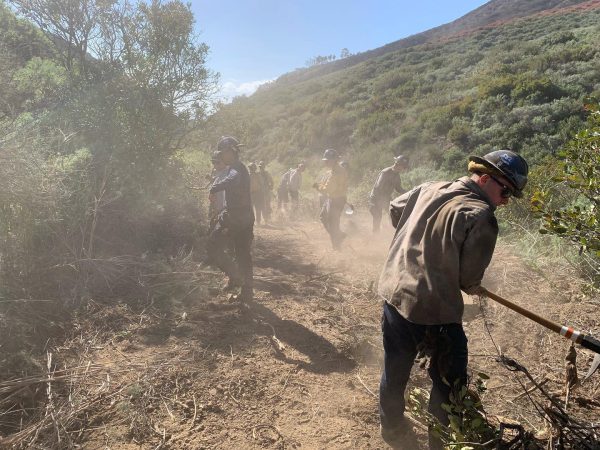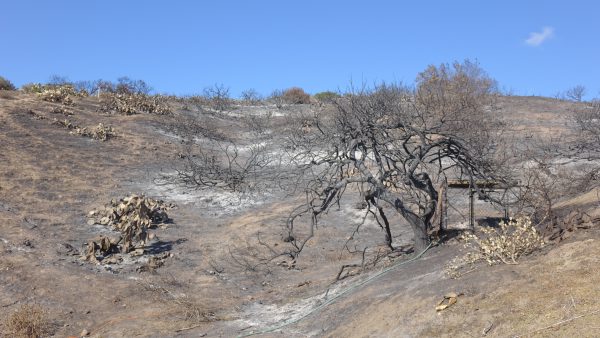
By Megan Miller, Special to the Independent
With environmental clean-up continuing on the Emerald Fire, fire officials are grappling with the task of restoring 154 acres of Laguna Beach’s once lush and diverse environment, now left ravaged by the blaze.
Conservationists are monitoring the hillside restoration but the Orange County Fire Authority has so far supervised and provided the crews performing the work, Hallie Jones, executive director of the Laguna Canyon Foundation, wrote in a text message.
The Laguna Greenbelt is home to a range of rare plant life and some threatened animal species. Though the fire burned just a fraction of the 22,000 protected acres, it serves as a significant warning of environmental hazards at a time fire officials say wildfire is a year-round threat.
“Wildfire is a natural and normal part of our environment,” Jones wrote in a statement. “While many of our native species can withstand and recover from a wildfire, the larger concern is the increased frequency and intensity of the fires we are seeing in today’s climate.”
Flames were spotted early morning Feb. 10, resulting in city-wide school shutdowns and mandatory evacuations in Emerald Bay and surrounding areas. Orange County Fire Authority reported 90% containment Feb. 12, but the task of clean-up and restoration continues to be an ongoing process.
“Our mission doesn’t end when the fire does,” OCFA wrote in a Tweet Wednesday, alongside photos that show crews re-carving fire breaks and covering open soil with cut vegetation to prevent erosion.
Kevin Pearsall, State Park Superintendent for Orange County, said Crystal Cove bore the brunt of fire, about 102 acres or two-thirds of the overall burn area. The other 52 affected acres are shared between county-owned Laguna Coast Wilderness Park and private property.
“We were disappointed in the end that most of the land was ours,” Pearsall said. “We are following the fire suppression repair that was finalized by the OCFA in consultation with state parks.”
In areas where firefighters made a stand to stop the spread of wildfire, soil berms and slash debris were pulled into control lines to minimize risk of soil erosion, Pearsall said.
“We don’t have a concern of that unless we have some phenomenal rain which we don’t see in the forecast,” he said.
Crystal Cove State Park will rely on natural regeneration of coastal sage scrub that’s often home to many threatened or endangered plant and animal species. California State Parks employees also have installed low-profile fencing and signage along Moro Ridge Trail and rangers are educating hikers to stay out of the burn area.
OC Parks is still unsure of how many acres of County land were burned in the Emerald Fire, agency spokesperson Marisa O’Neil said. She referred additional questions to OCFA after a reporter asked when county staffers might have a total of impacted county parkland.
Local environmental groups will likely step in to assist with the restoration process after OCFA has handled most of the clean-up, said Darin Loughrey, a spokesperson for Irvine-based wildlife conservation group Natural Communities Coalition.
Most of California’s coast, including the Laguna Greenbelt, is recognized globally as a biodiversity hotspot. This classification means the region is home to at least 1,500 unique plant species found nowhere else on Earth, and has already lost about 70 percent of its native plant life.

This rich biodiversity is what has led many local environmentalists to reconsider what conservation looks like in light of high wildfire risk. Orange County Fire Chief Brian Fennessy said in a Feb. 10 briefing, “We no longer have a fire season. We have a fire year.”
For the animal inhabitants, Norman Grossman, the president of environmental group Laguna Greenbelt, Inc., said smaller, slow-moving flames like the Emerald Fire aren’t life-threatening. But a larger and quicker blaze could have more devastating consequences.
He pointed to the firestorm of 1993, which destroyed some 366 homes and obliterated about 16,600 acres. It also claimed about one-fifth of Orange County’s population of California Gnatcatchers, a species of dainty gray songbird federally recognized as threatened.
“A heavier fire—a more catastrophic fire—I think would cause the damage we’re worried about,” Grossman said.
The protected greenbelt includes Crystal Cove State Park, Aliso and Wood Canyons, and Laguna Coast Wilderness Park. However, the string of land is isolated, which poses a problem for animal movement, Grossman said.
A proposed Irvine-Laguna Wildlife Corridor would allow passage of wildlife between the Laguna Greenbelt and 250,000 acres of land in the Santa Ana Mountains and Cleveland National Forest.
Not only would the corridor diversify species’ gene pools, some of which have recently seen mutations and illnesses caused by in-breeding, but Grossman said it would create an escape route for threatened animals in the case of fire.
“Things are getting drier and drier,” Grossman said. “So the preservation of the animal species is one of the main reasons we’re pushing this corridor.”
As for the scorched hillsides, Jones wrote that the Laguna Canyon Foundation will be working with OC Parks to keep a “very close eye” on invasive plant life that could take over the area from native species.
“Some parts of the impacted area will restore themselves naturally, while some areas might need a little help,” Jones said. “For now, the best thing that the public can do is respect the trail closures so we can minimize additional impacts on wildlife, the disturbed soil, and our native plants.”




